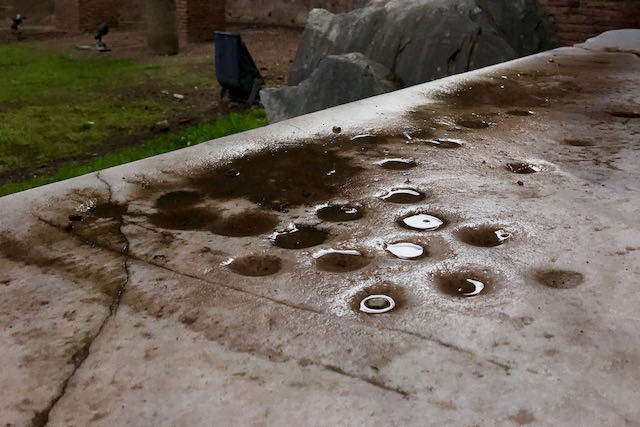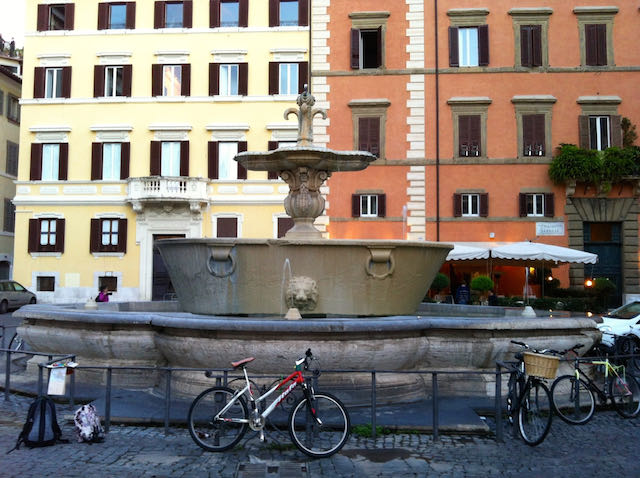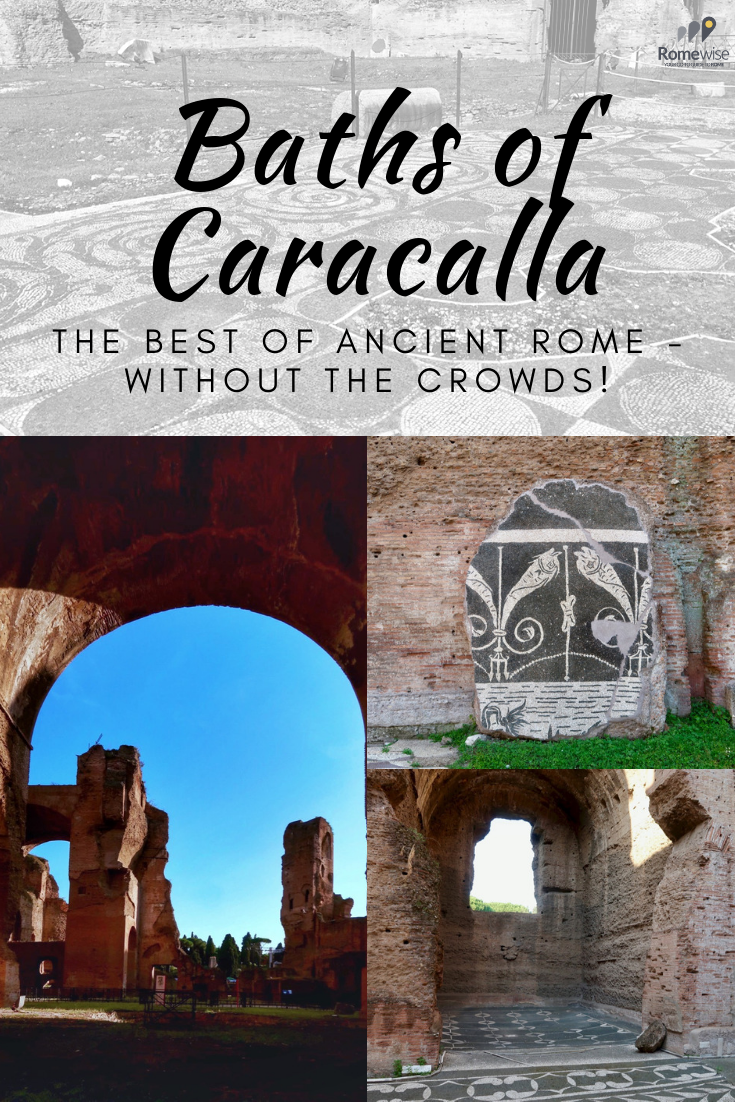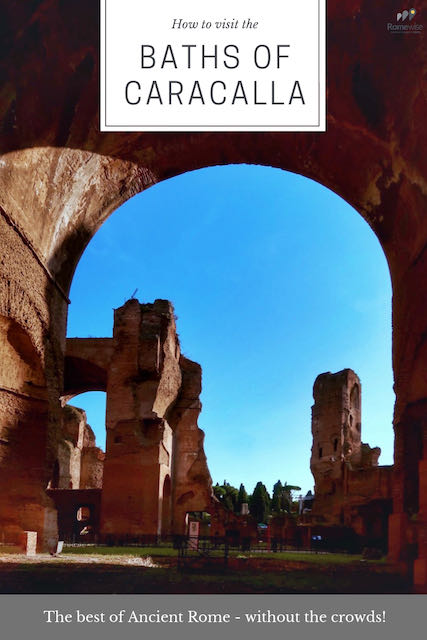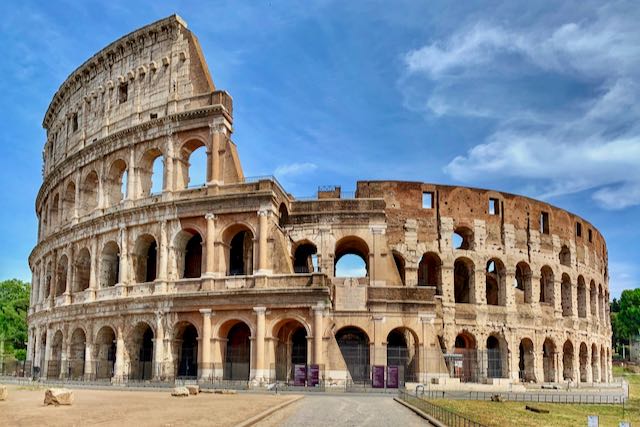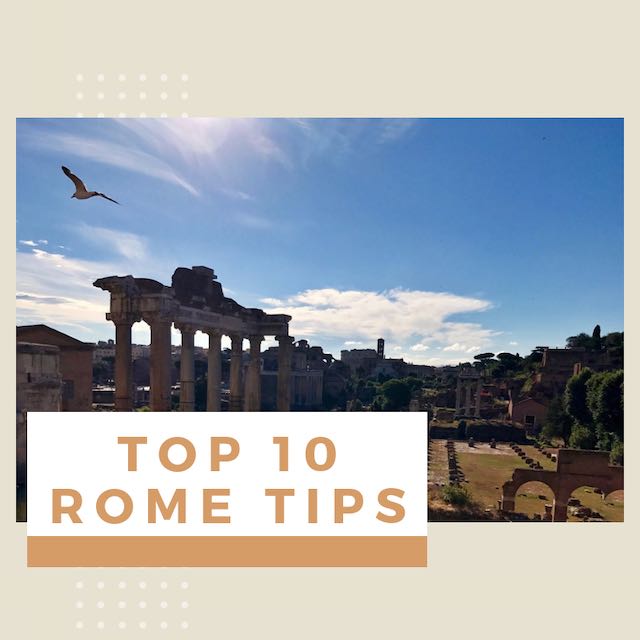- Sign up & get a FREE ebook Subscribe NOW!
- Romewise Home Page
- What to Do in Rome
- Romantic Things to Do in Rome
- Baths of Caracalla
Baths of Caracalla
Ancient Rome Without the Crowds
Tired of fighting the crowds at the Colosseum?
Don't miss the stunning Baths of Caracalla, one of the best ruins in Rome!
And no crowds or lines!
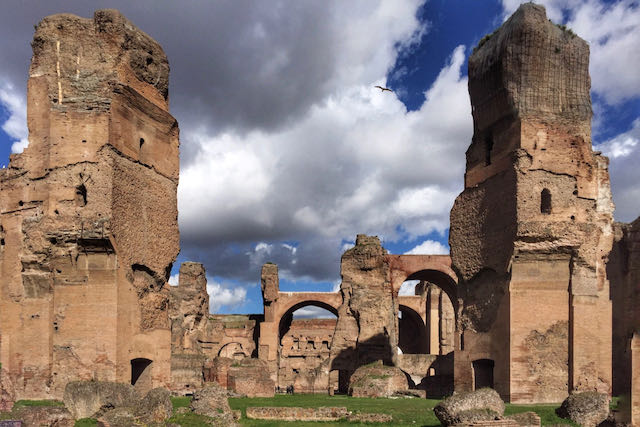 The Caracalla Baths, known in Italian as the "Terme di Caracalla", is one of the largest, most intact ruins from Ancient Rome that you can visit in Rome. And look - no crowds!
The Caracalla Baths, known in Italian as the "Terme di Caracalla", is one of the largest, most intact ruins from Ancient Rome that you can visit in Rome. And look - no crowds!The Ancient Caracalla Baths - Everything You Need to Know
This gargantuan set of ruins from the 3rd century C.E., known in Italian as the "Terme di Caracalla", showcases the skills the Romans had to make spectacular structures that have been able to stand the test of time.
How lucky are we that we can still visit them!
Here's everything you need to know about visiting the Caracalla Baths in Rome.
On this page, you'll find:
- What were the Baths of Caracalla and when were they made? How did people use them?
- Why you should visit the Caracalla Baths
- What you can see at the Baths of Caracalla
- All about the new Underground at the Baths of Caracalla
- How to visit the Caracalla Baths at night
- Practical Matters - opening times, costs, tickets for the Caracalla Baths
- How to attend a concert or opera at the Baths of Caracalla
- A map of the Caracalla Baths
What were the Baths of Caracalla?
The Baths of Caracalla were an enormous bath complex in Ancient Rome.
They were the second-largest baths in the Roman Empire (second only to the Baths of Diocletian, also in Rome, but less well-preserved.)
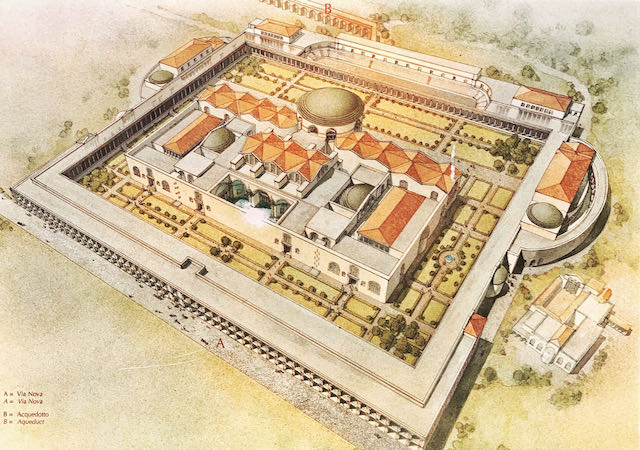 This rendering of the Baths of Caracalla is from the signs at the baths themselves. It allows us to see the enormity of the structure as it once was in Ancient Rome.
This rendering of the Baths of Caracalla is from the signs at the baths themselves. It allows us to see the enormity of the structure as it once was in Ancient Rome.They were available for Roman citizens to use for free.
It was not only a spa-like complex.
There were libraries, a gym with changing rooms, gardens, and a temple to Mithra (a pagan religion.)
This was the place to come for exercise, leisure, and almost most important of all, social networking.
Caracalla never got to see the baths completed.
He left Rome in 213 to maraud and rape and pillage other parts of the empire. He never returned.
Caracalla was one of the nastiest, most tyrannical of all the Roman Emperors.
And that's saying a lot when you consider the reputations of Nero, Caligula, Commodus, Domitian, and Diocletian, among others.
Caracalla was assassinated in 217 at the age of 29.
The baths were built during the reign of the Emperor Caracalla.
He was co-ruler along with his father Emperor Septimius Severus from 198 C.E. and later ruled with his brother Geta, emperor from 209.
Caracalla had his brother killed and became sole emperor of the Roman empire in 211.
He is credited with having the baths built, but it's probable the idea for them, and the design, began with his father, Septimius Severus.
Construction began in 211 and finished in 216 or 217.
The baths could hold up to 1,600 people at once, and around 6,000 - 8,000 people a day came to use them.
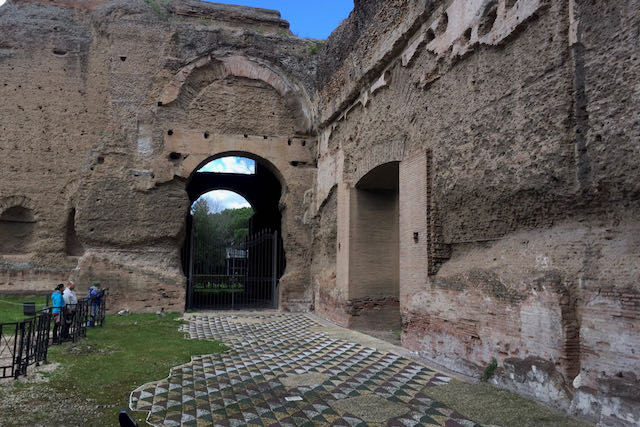 The Romans had mastered building techniques and engineering, and were able to make massive structures all over the empire, in part due to the cement they made, and in part due to the arch they perfected.
The Romans had mastered building techniques and engineering, and were able to make massive structures all over the empire, in part due to the cement they made, and in part due to the arch they perfected.There were several spaces in the baths themselves - a caldarium (a small space, much like a steam bath), a tepidarium (a larger, tepid room), a frigidarium (a larger, cold room), and a natatioio (a massive open-air swimming area.
There was a massive underground space (which is now open to the public), where the water supply and temperatures were managed.
The Baths of Caracalla were used for several hundred years until 537 when the Ostragoths destroyed the aqueducts that supplied water to the city and to the baths.
Rome remained without a fresh water supply for nearly a thousand years.
The perfect 3-day itinerary in Rome
Trying to figure out how to organize your visit to Rome? I've got the perfect 3-day itinerary for first-time visitors (or those who have not been here in a while.) It works for a 2.5 day visit as well.
In my 3-day itinerary, you'll see all the major must-see Rome attractions like the Vatican, Colosseum, Trevi Fountain, Pantheon, Piazza Navona, Spanish Steps, Castel Sant'Angelo, and much more.
And if you have more time, or want suggestions for extra/other things to do, you'll find that there too.
Visit my page with the best 3-day itinerary in Rome for first-timers.
Why you should visit the Caracalla Baths
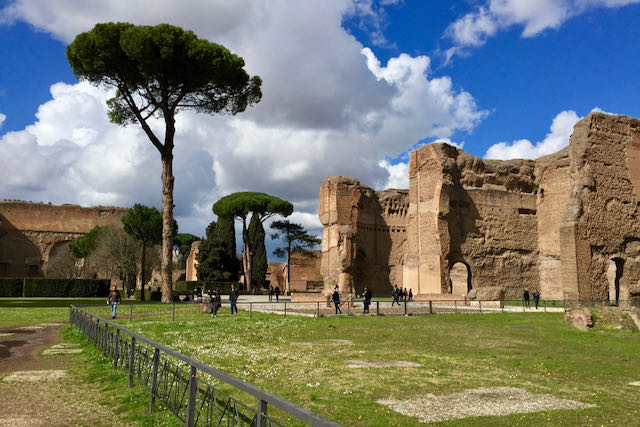 The Caracalla Baths are stunning in their enormity. They are a fantastic example of the skills of the Romans to build amazing structures. This is also a wonderful site to visit, as you can see the details up close and there are almost never crowds here. Bonus - there is a beautiful green park to relax in as well.
The Caracalla Baths are stunning in their enormity. They are a fantastic example of the skills of the Romans to build amazing structures. This is also a wonderful site to visit, as you can see the details up close and there are almost never crowds here. Bonus - there is a beautiful green park to relax in as well.In my opinion, this is one of the best sites you can visit in Rome.
- No crowds, no lines - It's an excellent way to enjoy a Roman ruin without the crowds you find at the Colosseum.
- Roman architecture - It will give you a good sense of the kind of building and engineering projects the Romans were capable of.
- See beautiful mosaics from Ancient Rome - You can also see up close the tiny inlaid mosaic floors, plus some other fragments of really beautiful decorative mosaics.
- Easy and stress-free - It's all flat (except for one staircase going to the underground), so it's easy to visit. There are also ramps. You can visit this site in about an hour if you just want a basic overview.
- Roma Pass - It's part of the Roma Pass and other City Passes, so you can get in free or with a discount if you have those passes.
Is a visit to the Caracalla baths for everyone?
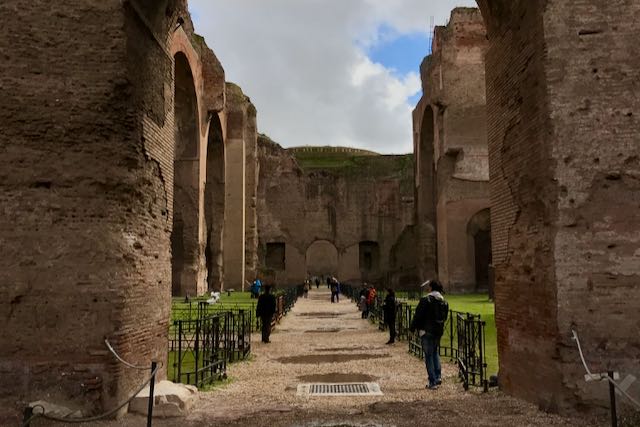 The Caracalla Baths are one of my favorite ruins to visit in Rome. It's usually pretty crowd-free, and you can enjoy some open air and green space too.
The Caracalla Baths are one of my favorite ruins to visit in Rome. It's usually pretty crowd-free, and you can enjoy some open air and green space too.This site is ideal for people of all ages.
It's relatively easy to see in about an hour if you just visit the main ruins, or in around 2-3 hours if you also visit the underground, use the virtual reality goggles tour, and explore the surrounding park.
Other than the underground, it's all one one level, and I don't find it exhausting.
Kids will enjoy this site, especially the virtual reality goggles and the underground.
Most of the site is handicap-accessible and there are many ramps for people in wheelchairs.
There are also accessible bathrooms.
This is an excellent site to visit for anyone who has been to Rome before and seen all the main sites, and for anyone who is passionate about Ancient Rome.
When it's open (rarely), the underground is enormous, well-lit, and well-ventilated, so it's not claustrophobic.
Ready to plan your trip?
Book your train
Planning to travel between cities in Italy and other parts of Europe?
Use Trainline to see all the different options available across the different rail companies.
Find your hotel
Find your perfect place to stay in Rome.
Use Booking.com to choose between hotels, guesthouses, and self-catering apartments in neighborhoods throughout the Eternal City.
Buy your TurboPass
Purchase the convenient Turbopass and visit all of Rome's top attractions including the Colosseum, Pantheon, and Vatican.
With one handy pass, it's all included.
What there is to see at the Caracalla Baths
When you visit the Caracalla baths, you can simply walk right in, without a guide, and enjoy the spaces.
There are plenty of signs, both at the beginning, and throughout, to explain the history of the baths, and also the spaces you are seeing.
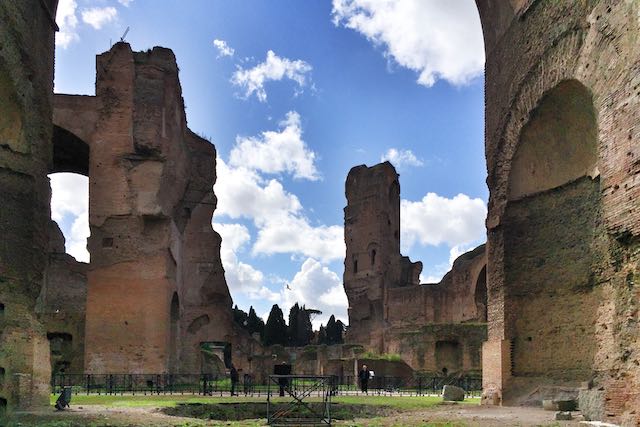 It's easy to visit the Terme di Caracalla on your own. There are signs throughout, making it easy to understand what you are looking at.
It's easy to visit the Terme di Caracalla on your own. There are signs throughout, making it easy to understand what you are looking at.You will see the much of the structure of the Baths of Caracalla, including the enormous natatioio (swimming area), where the different spaces were, like the gym, changing rooms, caldarium and other rooms.
In the natatioio, you can spot a poolside game they used to play.
You will also see huge fragments of mosaics of themes like sea animals, nature, or Roman gods.
Many of these came from the floor of the second level, which is gone now.
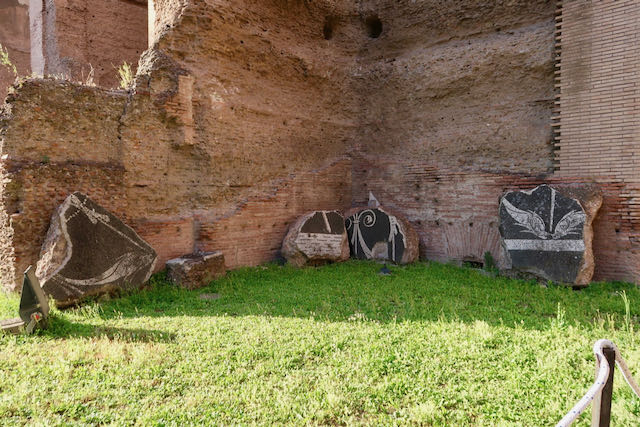 Throughout the site, you will see fragments of mosaics that would have lined the pools or other rooms in the giant bath complex.
Throughout the site, you will see fragments of mosaics that would have lined the pools or other rooms in the giant bath complex.You can stroll around the expansive gardens and even just relax there.
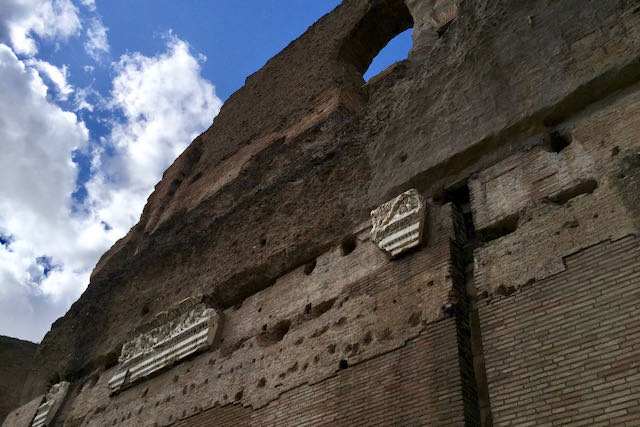 Visiting the Caracalla Baths is a great way to understand Ancient Roman architecture.
Visiting the Caracalla Baths is a great way to understand Ancient Roman architecture.And now, thanks to a long excavation, you can visit the underground, where all the technological stuff happened behind the scenes - where slaves stoked wood-burning fires to heat the bools, and where pumps pushed water up, among other things.
Stolen and Missing Art from the Baths of Caracalla
After the baths fell into disuse in 537 CE, they were abandoned and eventually looted and otherwise destroyed due to disuse and earthquakes.
Like many things from Ancient Rome, a lot of the materials used to build the baths in the first place were recycled to make other things during the Middle Ages and Renaissance.
Some of the marble and artwork was stolen and placed elsewhere.
What you won't see at the Baths of Caracalla are:
- Many of the giant granite columns that held up the upper floors. You can find these today in the church of Santa Maria in Trastevere.
- The stunning statues that were excavated in the Renaissance by the Farnese family. Two of the most important pieces, known as "The Farnese Bull", and "The Farnese Hercules" are in the Archeological Museum in Naples.
- Some of the more intact and intricate floor mosaics. They are in the Vatican Museums.
- Two giant fountains shaped like bathtubs were also pilfered by the Farnese family. Today they are in Piazza Farnese in front of Palazzo Farnese.
How long does it take to visit the Baths of Caracalla?
As I mentioned above, it can take no more than an hour to visit the baths, if you just visit the main site and walk around, without seeing the underground or other parts.
If you want to include the underground, which I highly recommend, give yourself at least 2 hours for everything.
If you also want to include the tour in 4-D with virtual reality goggles, make sure to allow at least 1.5 hours for that, plus another half hour at least for the underground, so again, 2-2.5 hours, 3 if you want to be very leisurely about it.
The new Underground at the Baths of Caracalla
When you see the ruins, and realize the scale, you'll be astounded to think of what must have happened behind the scenes to keep this all running.
Now, thanks to a long restoration and excavation, you can visit the underground and at least get a sense of the enormity of the space.
It's estimated there were around 50 brick ovens in the underground.
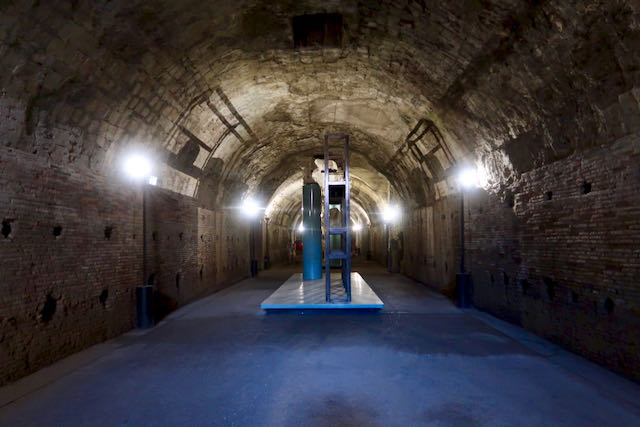 This gargantuan underground space, now open to the public, was needed for ovens that slaves would stoke to keep the water warm where needed. A visit here is wonderful!
This gargantuan underground space, now open to the public, was needed for ovens that slaves would stoke to keep the water warm where needed. A visit here is wonderful!There would have been slaves stoking fires constantly, keeping the caldarium hot 24 hours a day.
The huge tunnels underground contained around 2 miles of lead pipes, and a nearby aqueduct, made specifically to supply water for these baths, pumped about 20 gallons of water per second into tanks and pipes.
The underground space is easy to visit and not claustrophobic (it's enormous with mostly high ceilings.)
It should take you around 20-30 minutes to visit, depending how long you want to spend enjoying the exhibits (temporary and permanent) in the space.
How to visit the Baths of Caracalla at night
Once the summer opera season closes in early August, they take down the stage and theater.
Then, from late August through the end of September, you can visit the Caracalla Baths at night.
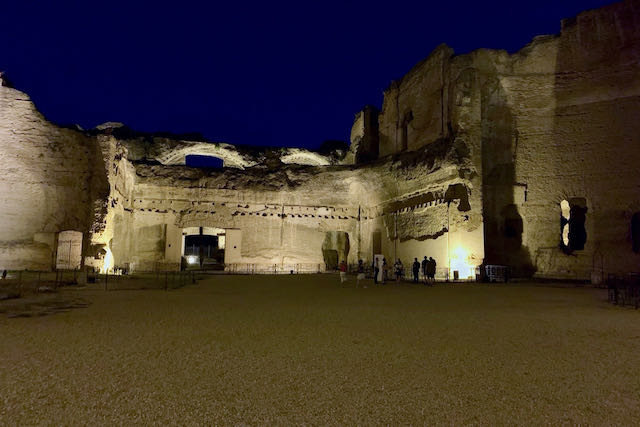 Seeing the Baths of Caracalla by night is a very special experience. You can do this from late August - late September.
Seeing the Baths of Caracalla by night is a very special experience. You can do this from late August - late September.This is another amazing experience I highly recommend.
The visits include a bit of a tour of the baths themselves, a bit of a visit through the new underground (see section above), and, the cherry on top, a visit to the Mithraeum, which you can only see on this tour.
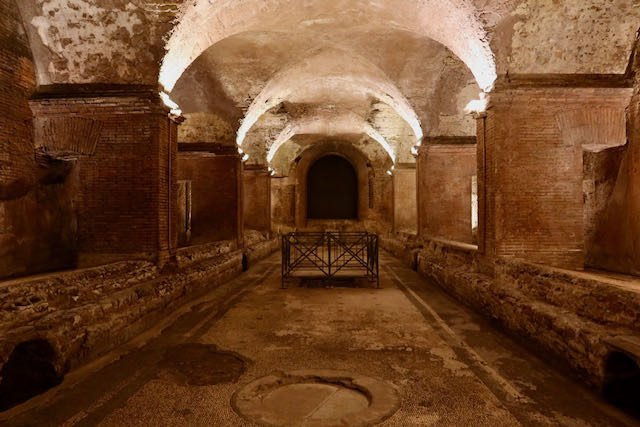 The Mithraeum - a place where worshipers of the ancient religion of Mithraism met and performed rites - under the Baths of Caracalla is a truly amazing space.
The Mithraeum - a place where worshipers of the ancient religion of Mithraism met and performed rites - under the Baths of Caracalla is a truly amazing space.Worshipers of Mithra met here and performed rites.
Mithraism is an ancient religion which also existed when Christianity began to spread.
It was seen as an alternative, but also as a rival to early Christianity.
By the end of the 4th century, Mithraism ceased to exist.
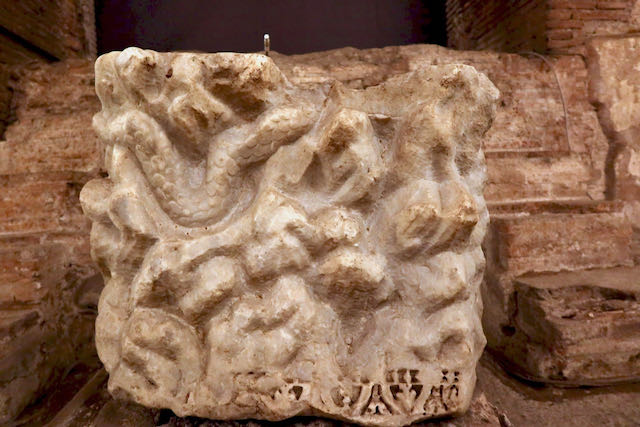 A closeup of the marble altar inside the Mithraeum in the Baths of Caracalla.
A closeup of the marble altar inside the Mithraeum in the Baths of Caracalla.Tours are in Italian or English and last 75 minutes.
They go Fridays and Sundays, about every 15 minutes between 8pm - 9:30pm.
You can book online at Musei Italiani.
You can also try to just show up on the evening you want to go, and see if they have tickets for sale on the spot.
You will probably get one, since this visit is not nearly as famous as the night Colosseum visits.
But if you want to be sure, and also pick the time you want, I suggest booking ahead.
Tickets are 20€, which is considerably more than during the day.
But you will have a guided tour, and you will get a very special visit with almost nobody else around you.
And you get the see the Mithraeum, which to me is alone worth the price.
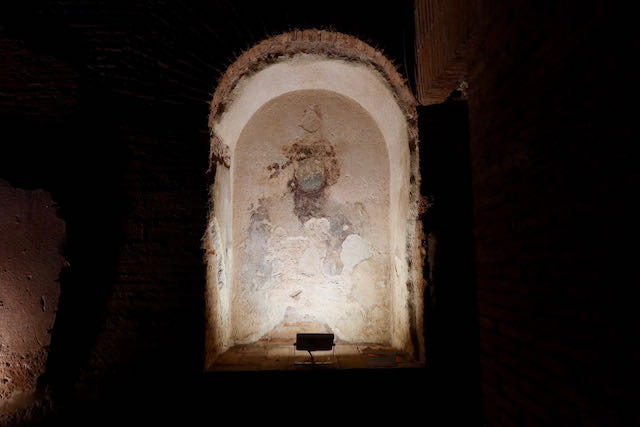 This fresco of the god Mithra is in the Mithraeum underneath the Caracalla Baths. How amazing to see something this old survive the millennia.
This fresco of the god Mithra is in the Mithraeum underneath the Caracalla Baths. How amazing to see something this old survive the millennia.Baths of Caracalla - Opening times, costs, tickets
Opening Hours for visiting the Caracalla Baths
The baths are open daily except for December 25 and January 1 when they are closed.
They open at 9am, and closing hours depend on the season. They have similar closing times as the nearby Palatine Hill and Colosseum, i.e. around sundown.
Last entry is one hour before closing, although they start shooing you out a bit before that.
The underground closes one hour before closing time also.
The 4-D virtual reality tour takes 1.5 hours, and the last time available to rent this equipment and take the tour is 2.5 hours before closing.
On Mondays the site closes at 2 pm.
Closing times for the rest of the week throughout the year are:
- 4:30 pm - From the last Sunday of October to 15 February
- 5:00 pm - From 16 February to 15 March
- 5:30 pm - From March 16th to the last Saturday of March
- 7:15 pm - From the last Sunday of March to 31 August
- 7:00 pm - From 1 September to 30 September
- 6:30 pm - From 1 October to the last Saturday of October
- 8pm for night visits late August - late September
Disclosure: If you make a purchase through a link on this page, I may receive a small commission - at no extra cost to you. Thank you for supporting my site!
Caracalla baths tickets, costs, roma Pass
Normally standard daytime tickets cost 8€.
If there is an exhibit, tickets may cost more.
Ticket prices are reduced for European citizens between 18-25 years of age, and cost 2€.
Everyone under 18 is entitled to free entry.
The site is one of the "Sunday at the Museum" sites that is free on the first Sunday of the month.
The Caracalla Baths participates in the Roma Pass and other Rome City Passes, so you can either use the pass for free entry here, or for discounted entry.
You don't really need to book in advance.
I have never once arrived to find a long line at the ticket counter.
If you want to book in advance, you can visit Musei Italiani.
You can also get a 3-D Virtual Reality headset for an additional 7€.
You can buy this on site.
You'll need to get your headsets at least 2.5 hours prior to closing time.
How to attend a concert or opera at the Caracalla Baths
In summer you can attend a music concert, a ballet, or an opera at the Caracalla Baths.
Here's when and how:
Operas at the Baths of Caracalla
On July 7, 1990, Spaniards Plácido Domingo and José Carreras and Italian Luciano Pavarotti gave their very first concert together, as "The Three Tenors."

It was held on the eve of the World Cup, which was in Rome that year.
And it was held at the Baths of Caracalla.
On that night, two traditions were born - the Three Tenors would go on to delight music and opera fans around the world for years to come.
And, the Baths of Caracalla began holding operas there every summer, with the baths creating a dramatic backdrop.
The operas are put on by the Rome Opera, so you can count on a high-quality production, with world-class stages, musicians, and singers.
Concerts are only in July through the beginning of August.
Visit my page about Rome events in July to see the most current operas and concerts.
To see the schedule, and to purchase tickets, visit TicketOne.
Attending a concert at the Caracalla Baths
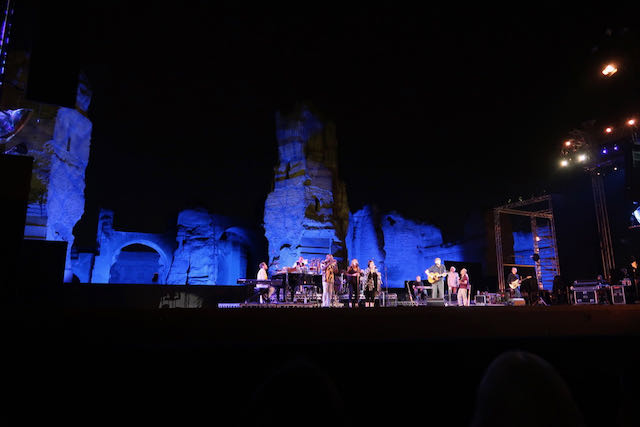 This is when I saw James Taylor and Bonnie Raitt in concert at the Baths of Caracalla. It was phenomenal! Not just the music and the artists, but the setting. And the acoustics!
This is when I saw James Taylor and Bonnie Raitt in concert at the Baths of Caracalla. It was phenomenal! Not just the music and the artists, but the setting. And the acoustics!The Baths of Caracalla are also a fantastic venue for music concerts.
I was fortunate to see James Taylor play here with Bonnie Raitt.
Shows in recent years have included Neil Young, Björk, Ennio Morricone, and Elton John.
You can use the same link above to see concert schedules and purchase tickets on the authorized ticket vendor TicketOne.
Map of the Baths of Caracalla
Below is a map of the Baths of Caracalla, and other points of interest nearby, including the closest Metro stop (a 5-minute walk), and a few places to eat in the area.
Romewise's Top Travel Resources
Ready to book your trip to Rome? Take a look at these helpful links to companies we use and trust:
- Keep your travel spending simple with the Wise card, which removes all the worry about exchange rates and high transaction fees all over the world
- Search for and book your perfect accommodation
- Our complete guide to what to pack for Rome
- The number one travel accessory, a multi-point travel adapter and voltage converter
- Browse a huge range of tours in Rome and beyond
- Experience unique tours and special access to Rome's most popular sights
- Protect yourself with comprehensive travel insurance
Within this post there are some affiliate links for products and services. For more details about our affiliate policy click here.
Get your 100% free Rome trip planner now!
Simply sign-up today for our free newsletter and get the Romewise Quick Start guide to Rome:
We are committed to respecting your data. Click for our Privacy Policy.
Comments? Questions? Suggestions?
Please come over to the private Romewise Facebook group and join in the conversation.
You will often find me there, happy to answer your questions / comments!
You will also meet other Rome lovers and experts, too.
What are you waiting for?
- Romewise Home Page
- What to Do in Rome
- Romantic Things to Do in Rome
- Baths of Caracalla

